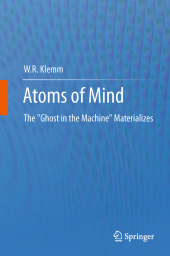 Neuerscheinungen 2014Stand: 2020-02-01 |
Schnellsuche
ISBN/Stichwort/Autor
|
Herderstraße 10
10625 Berlin
Tel.: 030 315 714 16
Fax 030 315 714 14
info@buchspektrum.de |

W. R. Klemm
Atoms of Mind
The "Ghost in the Machine" Materializes
2011. 2014. xix, 355 S. 235 mm
Verlag/Jahr: SPRINGER NETHERLANDS; SPRINGER 2014
ISBN: 9400797540 (9400797540)
Neue ISBN: 978-9400797543 (9789400797543)
Preis und Lieferzeit: Bitte klicken
This book describes how the mind "thinks", including the nonconscious, the subconscious and the conscious mind; includes current theories of consciousness, and the author´s own theory based on patterns of nerve impulses in circuits interlaced in larger networks.
This book describes the author´s view of how the mind "thinks" at various levels of operation. These levels include nonconscious mind (as in spinal/brainstem reflexes and neuroendocrine controls), subconscious mind, and conscious mind. In the attempt to explain conscious mind, there is considerable critique of arguments over whether or not free will is an illusion. Finally, the author summarizes current leading theories for consciousness (Bayesian probability, chaos, and quantum mechanics) and then presents his own theory based on patterns of nerve impulses in circuits that are interlaced coherently into larger networks.
1. The Quest.- 2. Thinking About Thinking.- 3. Kinds of Mind.- 4. Carriers and Repositories of Thought.- 5. Specific Thought Mechanisms & Examples.- 6. Global Interactions.- 7. On the Nature of Consciousness.- 8. Theories of Consciousness.- 9. Conclusions.
Dr. W. R. (Bill) Klemm, a Professor of Neuroscience at Texas A&M University, is a brain researcher who has written ten books on brain and behavior. His analyses are esteemed by journal editors who have called on him to serve on the Editorial Boards of eleven scholarly journals and to peer-review on the order of a thousand papers for over 55 research journals. His breadth of neuroscience research experience serves him well in addressing such complex issues of how brains think. His 425+ scholarly papers include works on over a dozen neuroscience areas, such as neuronal membrane biochemistry, brainstem mechanisms of arousal and movement inhibition, spike-train interval coding, alcohol and narcotic mechanisms, learning/memory, hormone action on the nervous system, pheromones and behavior, sleep physiology, anesthesiology, animal and human electroencephalography, and human cognition.


